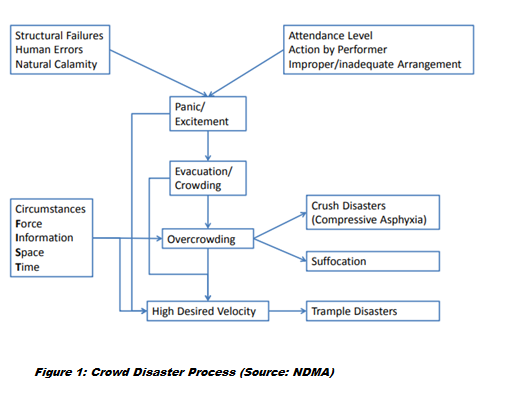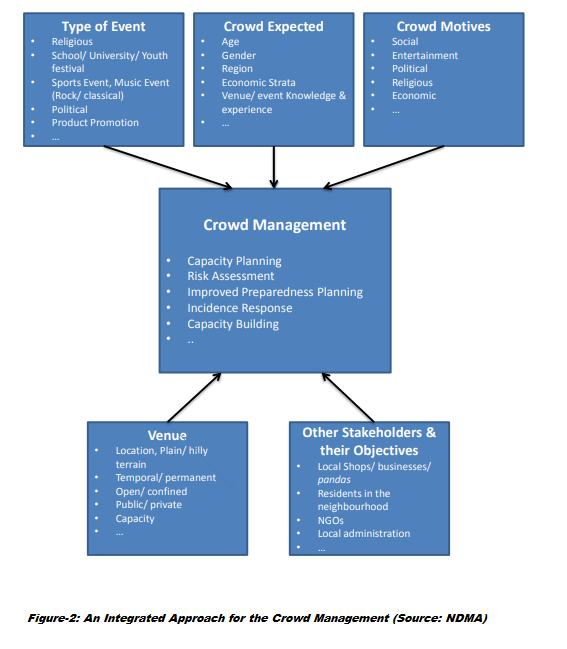Stampedes and NDMA guidelines on crowd management
2023 JAN 6
Mains >
Disaster Management > Disasters > Disaster Management Act, 2005
IN NEWS:
- Recently, the Andhra Pradesh government has banned assemblies and processions on public roads and streets in the wake of two stampedes at the public rallies of the Telugu Desam Party (TDP) in a span of four days that claimed 11 lives.
STAMPEDES:
- The term stampede is applied to a sudden rush of a crowd of people, usually resulting in many injuries and death from suffocation and trampling.
- Stampedes are caused by surge of individuals in a crowd, in response to a perceived danger, loss of physical space or excitement.
- Data available with the National Crime Records Bureau (NCRB) indicates that there have been a total of 3550 incidents of stampede in the country from 2001 to 2015 resulting in the death of 2901 people.
- A 2013 study published by the International Journal of Disaster Risk Reduction (IJDRR) points out that religious gatherings and pilgrimages have been venues for 79% of the stampede in India.
CAUSES AND TRIGGERS OF CROWD DISASTERS (OR STAMPEDES):
- Structural:
- The collapse of barricades, barriers, makeshift bridges, temporary structures, and bridge railings due to panic caused by rumour.
- Other structural causes that trigger crowd disasters include, difficult terrain (famous religious sites built on top of hills that are difficult to access),slippery/muddy roads ,narrow streets with illegal vendors on sides, poor guard railings, poorly lit stairwells, windowless structure, narrow stairs, narrow and very few entry/exits , absence of emergency exits.
- Crowd control:
- Causes and triggers that are associated with poor crowd control and management include underestimation of the audience, inadequate staffing and services, people allowed in excess of holding capacity due to overselling of tickets for an event, a limited holding area before the entrance, the sudden opening of the entry door, reliance on one major exit route, and a lack of a proper public address system to control the crowd.
- Crowd behaviour:
- Causes that are associated with crowd behaviour include, unruly and irresponsible crowd behaviour, panic created due to spread of some rumours and a wild rush to force the way towards exits, sudden flow of people in reverse direction, a large (much more than expected) anxious and competitive crowd gathering because of limited period promotional events at malls etc.
- Fire/Electricity:
- These include, fire in a makeshift facility or a shop, non-availability of fire extinguisher/fire extinguishers not in working condition, building and fire code violations, lack of adequate flood lighting of the assembly area and the path ways use by the crowd ,electricity supply failure creating panic and triggering a sudden exodus, illegal electric connections, elevators catching fire etc.
- Security:
- Triggers of a crowd disaster associated with inadequate security and surveillance measures include, under deployment of security personnel to regulate to control crowd, lack of adequate scientific planning in making police arrangement to deal with crowd with proper sectoral deployment under an officer with adequate manpower, lack of adequate dress rehearsals before actual deployment, lack of adequate CCTV surveillance of the crowd with PA system to control monitor and guide as and when required etc.
- Lack of Coordination between Stakeholders:
- Coordination gap between agencies (e.g. Commissioner / Superintendent of Police and District Magistrate; PWD, Fire Service, Forest officials, Revenue officials, Medical officers and shrine management etc.),lack of understanding of the range of duties entrusted ,communication delays , vacant/late/delayed posting of key personnel etc.

|
Force, Information, Space and Time (FIST)
- Fruin suggested that Force, Information, Space and Time (FIST) are the main factors that influence the occurrence of crowd disaster. (Figure 1)
- F - Crowd Force,
- I - the Information (false or real) upon which the crowd acts,
- S -the physical Space (seating area, chairs, corridors, ramps, doors, lifts etc.) involved
- T - the Time duration of the incident (rapid ingress/egress) play a very important role resulting in either overcrowding (high crowd density: a large number of people per unit area) or high desired velocity (accelerated movements).
|
NDMA GUIDELINES ON CROWD MANAGEMENT:
- Understanding Visitors and Stakeholders:
- The basic element of event/venue planning is to understand the visitors. This, however, is largely determined by the type of event (religious, youth festival, school/university event, cricket/sports event, music concerts, political gathering); season in which it is conducted; and the type and location of the venue (temporal/permanent, open/confined spaces, bus stand, rail/metro station, plain/hilly terrain).
- Based on this and from prior knowledge and experience, one can and should attempt to determine the type of crowd expected (age, gender, region, locals/visitors, people with special needs etc.) and their estimated numbers.
- Risk Analysis and Preparedness:
- It is widely acknowledged that “Prevention is better than cure”, and the first aim of any Crowd Management process is to prevent a serious situation from developing.
- Disasters may often be prevented from happening through careful identification of causes/threats; assessing the risks posed by them.
- Information Management and Dissemination:
- The review of past disasters indicates that in the absence of necessary information, people may slow down/panic; change their direction during their movements leading to undesired flows and/or undesirable behaviour.
- While the absence or poor information management in itself can be a source of crowding, the appropriate information and its dissemination can be a useful weapon in managing crowds.
- Information System for Visitors:
- An advisory on what is recommended, allowed and not allowed to be carried along (torch, food, water, medicine, winter clothing etc.),maps with places of importance (event venues, hotels, food joints, hospitals police stations etc.), event route maps with entry/exit points, locker rooms etc.
-
- Information / Data for Venue/Event Organizers:
- Venue/Event Organizers and administrators should have the following data/information : Past data on number of arrivals, patterns , Likely arrival times, means of arrival and needs .
- Information / Data for Security Personnel Security Personnel should have the following information with them:
- A detailed map showing entry/exit routes, holding areas, location of emergency services etc,intelligence on visitors, likely problematic visitors,timing of peak activities, the routes and venue details, critical control points, evacuation and response plans.
- Safety and Security Measures:
- Generic Safety and Security Guidelines:
- Watch towers at all vantage locations with reserve with wireless communication network to assist in case of problem, CCTV monitoring of the entire crowd sector wise at the main control room, mini UAV for observing the overall crowd in case the crowd spread is too big, etc.
- Specific Fire and Electrical, Structural Safety Guidelines:
- Organisers should ensure authorised use of electricity, fire safety extinguishers and other arrangements meeting safety guidelines.
- Deployment of Barriers:
- Barricades, roadblocks and fencing may be deployed in target areas as deemed fit.
- These can be deployed to control the flow of pedestrians, hostile groups, and vehicles.
- The type and material of the barriers should be in line with the intended purpose, crowd density and force expected. For example, roadblocks for vehicular movements should be made up of large, heavy objects and should cover the complete width of road including footpath, if any.
- Care should be taken that the barriers should be strong and safe as people, at time, may lean against them.
- Facilities and Emergency Medical Services:
- A fully equipped medical unit can be stationed at the venue during the major events/festive seasons with all lifesaving facilities.
- Ambulances should be located in a way that they always have unblocked, escape route.
- Have an up-to-date list of all local hospitals, primary health centres including private nursing homes, and mobile hospitals with their capacities.
- Transportation and Traffic Management:
- The guiding principles in transportation and traffic management should be to use public transport as much as possible and minimize the impact of undesirable crowd and traffic.

|
NDMA guidelines in the event of a stampede:
- In case a stampede breaks out, protect your chest by placing your hands like a boxer and keep moving in the direction of the crowd.
- Stay alert to open spaces and move sideways wherever the crowd gets thinner.
- Stay away from walls, barricades or bottlenecks such as doorways.
- Stay on your feet and get up quickly if you fall.
- If you get injured in the process and can't get up, use your arms to cover your head and curl up like a foetus so that your exposure area is reduced.
|
PRACTICE QUESTION:
Q. Discuss why stampedes repeatedly occur in India. What can be done to prevent such stampedes?

